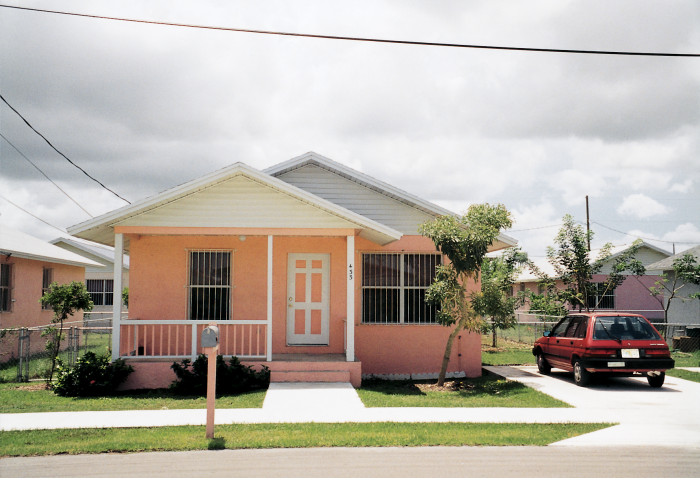


デイド郡南部のジョーダン コモンズは、ハリケーン アンドリューの低所得被災者のために建設中の、革新的でエネルギー効率の高い住宅開発です。このプロジェクトの目標は、フロリダ州の低価格住宅のモデルとなるエネルギー効率の高い地域を建設することです。ハビタット フォー ヒューマニティは 40 エーカーの土地を開発し、約 150 軒の住宅の建設を監督します。
住宅の広さは 950 ~ 1,450 平方フィートとさまざまで、フロリダ太陽エネルギーセンター (FSEC) が推奨するさまざまなエネルギー効率対策が施されています。
- エネルギー効率の高いエンベロープ設計
- 遮光窓または低透過窓
- 反射する白い屋根と明るい色の壁
- 空調空間内のダクトシステム
- 風景の陰影
- 小型高効率エアコン
- 太陽熱温水器
- 低流量シャワーヘッド
- 効率的な冷蔵庫
- コンパクト蛍光灯
おそらく最も重要なのは、省エネ機能を取り入れた家庭が 1 年間監視され、エネルギー節約が記録されることです。これはめったに試みられることのない概念実証です。フロリダ エネルギー オフィスの支援を受けて、FSEC はエネルギー効率の高い開発地区の 10 軒の住宅を監視し、近隣のフロリダ シティにあるエネルギー効率の高い機能のない 10 軒の対照住宅と比較しています。両方の地区で、家庭の電力使用量、建物の状態、気象条件が監視されます。
温度測定は、T 型熱電対を使用して行われます。周囲空気センサーは、通気口のある筐体内に設置することで、直接放射から保護されています。静電容量型湿度トランスミッターは、温度補正された RH 値を提供します。カップ型風速計は、屋根のラインから 1 メートル上に取り付けられています。日射量は、屋根の上にある水平に取り付けられたシリコン セル日射計を使用して測定されます。窓の換気は、操作可能な窓に取り付けられた磁気接触スイッチから取得され、信号がデータロガーに送信されます。電力消費量は、8 つの 50 アンペアおよび 200 アンペアのパルス開始電力トランスデューサーを使用して評価されました。
CR10 データロガーは、5 秒間隔で計測器データを読み取ります。積算値または合計値は 15 分ごとに保存されます。データは毎晩データロガーからメインフレーム コンピュータに転送され、各サイトで測定された毎日のパフォーマンス パラメータを要約するために自動的にプロットされます。プロジェクト エンジニアは翌朝プロットを確認し、信頼性の高いデータ収集を確実にします。
FSEC の研究エンジニアは、1994 年 7 月にデータロガーと関連機器を設置して 10 か所のコントロール グループ サイトを監査しました。私たちの知る限り、この取り組みは北米の低所得者向け住宅におけるエネルギー最終使用データの最も野心的な収集を表しています。
計測器を設置する前は、家庭内での給湯エネルギーは他のどのエネルギー使用量よりも多くなるだろうと多くの人が予想していました。給湯使用量は居住状況と密接に関係しており、対照住宅では平均して 1 世帯あたり 4 人以上が住んでいます。しかし、データによると、エネルギー使用量のほぼ半分は空調に使用されていました。次に多い給湯使用量は 18 パーセントと、はるかに低い値でした。事前監視の推測はここまでです。
エアコンのデータをさらに調査すると、興味深い事実が浮かび上がりました。ほぼ同一の 10 軒の対照住宅では、エアコンの使用量が 5:1 で異なっていました。しかし、ここでも詳細なデータにより、違いを明確に把握できました。サーモスタットの設定により、住宅間のエアコンのエネルギー使用量の差の 80% 以上が説明できることが分かりました。サーモスタットが 81°F 未満に 1 度設定されるごとに、エアコンの使用量は 12% 増加しました。
このようなデータに基づいて、私たちは効率的な住宅の建設を改善するために、より情報に基づいた決定を下すことができました。しかし、本当のテストはまだ始まったばかりです。現在ジョーダン コモンズが建設中であるため、FSEC は 10 軒の実験住宅に監視装置を設置する予定です。1 年間の比較監視の終了時に、ジョーダン コモンズで収集された蓄積データは、フロリダ シティのコントロール グループ ホームから収集されたデータと比較分析されます。その結果により、エネルギー効率対策のパフォーマンスを検証でき、次の世紀に向けてフロリダの手頃な価格の住宅を改善するための基礎となるはずです。
ケーススタディの概要
アプリケーション
エネルギー効率の高い住宅プロジェクトを支援するために、家庭の電力使用量、建物の状態、気象条件を監視する場所
米国フロリダ州デイド郡使用製品
CR10寄稿者
Danny S. Parker and John R. Sherwin, Florida Solar Energy Center, Cocoa, Florida参加団体
フロリダ太陽エネルギーセンター計測項目
家庭の電力使用量、気温、日射量、相対湿度、風速、地表温度、水温などの気象条件、建物の状態関連ウェブサイト
Florida Solar Energy CenterPDFで見る